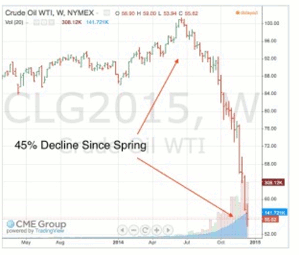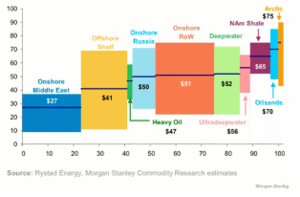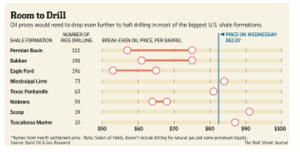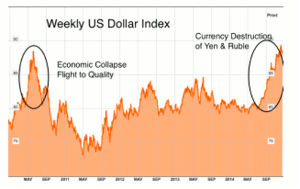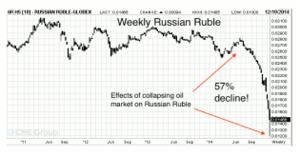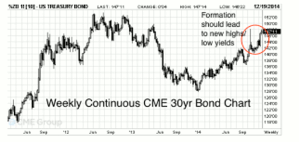Andy Waldock of Commodity & Derivative Advisors discusses the relationship between US crude oil, the economy, and global currencies and suggests that, though cheap oil is roughly good for the economy overall, too much is never a good thing in the markets.
The crude oil market has declined by approximately 45% since this summer. The massive decline has surpassed most analysts' expectations including those who advise sovereign nations on international foreign trade issues. The biggest problem most of us face is determining the difference between falling oil prices and gasoline being a good thing at the personal, micro level compared to the damage that falling oil prices have had on equity and currency markets at a macro level. Unfortunately, the answer lies on a continuum rather than an easy black and white answer or a single numerical value. This week, we'll look at differences in the economic makeup of the major players and determine where they stand in terms of currency and budgetary risks due to oil's precipitous decline.
First, we need to look at the oil market itself. The global crude oil market had always been relatively well balanced due to relatively few suppliers colluding on price in a highly capital intensive business model. These factors, along with generally low pre-9/11 oil prices combined to suppress new competitors within the existing market structure. The post-9/11 landscape sent oil above $100 per barrel for several years and peaked all the way up at $140 per barrel. The sustained high prices—combined with new oil fracking technology—has created a revolution within the oil industry and has put the US on the fast track towards energy independence. Furthermore, it has done wonders for the domestic employment situation as well as adding to the tax base, both directly through economic activity and also as a refund of sorts as domestic gas prices decline, leaving more money in the private citizens' pockets.
The rapid and steep decline in crude oil has been a boon to the private citizen and a bane to oil exporting countries.
The real issue is determining the inflection point between consumers' extra spending in the overall economy due to their new found savings versus the decline in corporate profits the energy sector incurs as prices fall. Therefore, the first place to look is the extraction costs of oil from the different extraction methods and geographical locations.
Breakeven prices for various types oil extraction and geographical locations.
Here is a more in depth look at our domestic oil shale picture from the Wall Street Journal.
Detailed view of the cost of production within major US shale oil plays.
Currently, West Texas Intermediate (WTI) crude oil has bottomed in the mid $50s. These prices make almost all domestic shale oil plays unprofitable. In fact, these prices eliminate the profitability of almost all new oil rigs and techniques. Below $60 per barrel, only the old school oil rigs and oil producing countries remain profitable.
NEXT PAGE: The Foundation of the Crude Oil Market
|pagebreak|However, just because they remain profitable at lower production volumes by today's standards, it doesn't address the actual actions that may be taken by major players if prices remain low for an extended period. Understand that if oil production above $60 per barrel is taken off line, the older wells will be required to increase their capacity. However, if they could've increased their capacity that much to begin with, oil prices would've never climbed high enough to make current shale and tar sands oil a profitable venture. Thus, leaning on cheap, old, and proven reserves may not be the guarantee the world wants to see. Finally, remember that cutting expensive production will also consolidate the economic power of oil rather than democratize it as more nations come into play at slightly higher prices.
Now that we've established the foundation of the crude oil market, we need to shift towards sovereign currency policies within oil producing nations. Crude oil the world over is traded in
US dollars. It's been this way since the CIA installed the Shah of Iran in the 70s and with "The Kingdom" even longer than that. Because oil is traded in dollars, there is a direct inverse relationship between the currency and the product. Classically, crude oil will fall as the dollar rises due to an increase in the dollar's purchasing power against the local currency in which the oil was drilled. The inverse is equally true. The recent tumble in the price of oil has been equaled by the recent move in the US dollar index and the Russian ruble.
The US dollar has moved to multi-year highs as Japan and Russia have lobbed the first volleys of currency destruction.
The Russian ruble has declined by nearly 60% since the middle of June.
Comparing the ruble and dollar to the price of oil, we can clearly see two important points. First of all, the ruble's decline above and beyond the price of oil is due to two things, sanctions and currency flight. Secondly, the rally in the dollar is based as much upon the forecasted economic strength of the US economy as it is upon the forecasted Russian recession.
This is when it helps to look for secondary clues. Secondary to the US equity markets is the US bond market. Dollars pouring into bonds from across the globe have pushed yields back towards the lows. Furthermore, the bond's chart pattern suggests that this could easily be a rally towards record low yields. Obviously, the market is expecting yields to fall as global growth slows, which will force the euro and yen into further easing strategies. One final note on the global interest rate environment: Russia's surprise hike in their rate to 17% was an attempt to prop up the ruble. However, rising interest rates only attract capital that is expected to be repaid. Moody's cut Russia's credit rating to Baa2, which is one notch above the lowest investment asset this past October.
Bond futures could climb to all time highs reflecting record low yields as the dollar becomes the primary currency.
Cheap oil is roughly good for the economy overall. However, I hope this piece proves that too much is never a good thing in the markets. They're like deer. One must move slowly and deliberately while taking into account all of the elements of the environment. So it is with these markets. Keep the powder dry and be sure and look from more than one angle.
By Andy Waldock, Founder, Commodity & Derivative Advisors

